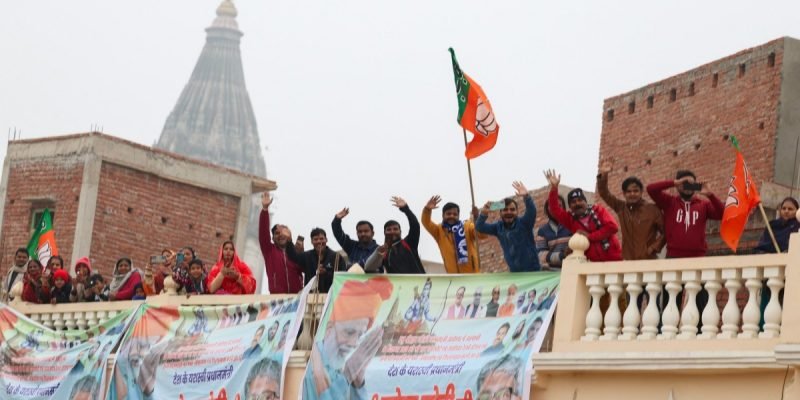Regardless of some dissonance in the INDIA coalition in the context of seat-sharing for the Lok Sabha polls in some states, and in spite of the industrial-scale propaganda on the upcoming inauguration in Ayodhya of a half-constructed temple to Lord Ram – which Hindu scriptures and tradition forbid – Prime Minister Narendra Modi’s BJP is likely to face an uphill task in the upcoming parliament election.
Positive results flowing from the false religiosity and communal spirit being sought to be engendered in quest of electoral gain through the construction of a temple seem unlikely, as we shall see in the discussion below.
For the BJP, there is another disquieting probability – the tactical surfacing of deep dissatisfaction in sections of the party with the arrogant and presumptive attitudes, actions and style of functioning of the clique at the top that is seen to be dismissive of the opinions of leading party hands outside the charmed circle.
This is fairly evident in some parts of the Hindi belt, which is crucial for the Modi BJP.
In most parts of the country, and for many Lok Sabha seats, it seems that the BJP may find it hard even to name viable candidates. This situation is likely to be the exact opposite of the situation in states where the Modi BJP seems the master of all it surveys.
These are states, bar a couple, where the saffron party has its own chief minister – namely Uttar Pradesh, Madhya Pradesh, Chhattisgarh, Rajasthan, Gujarat and Assam. These yield 179 Lok Sabha seats and are the BJP’s best bet.
The BJP also has its CM in Haryana and Uttarakhand (together 15 seats), but in these it is apt to face a lively challenge.
In Maharashtra (48 seats), the BJP is in power in an alliance government and could win about half the seats.
In Karnataka (28 seats), the party was ejected from office by the Congress last May but enjoys a widespread presence, though its organisational abilities appear to have suffered in the wake of the stinging defeat in the assembly election. The party here also seems to acutely feel the absence of an acceptable leader.
The states named above make up 270 Lok Sabha seats out of a total of 543; that is, about 50% of all seats.
In the best category of 179, where the party seems beyond effective challenge, it had won nearly 80-90% of the seats in 2019, and there is not much scope for improvement. If the INDIA parties – in the context of these states, the Congress, the Samajwadi Party and the Rashtriya Lok Dal – are smart, they have the potential to snatch some seats, but not many, here.
In this effort, the election of Mallikarjun Kharge – a stalwart figure of Dalit background – as Congress president and INDIA coalition chairman, is a decided plus. Elsewhere in the country, including the other states where the BJP enjoys salience, the Kharge factor can become a force multiplier for the opposition grouping.
The east-to-west Nyay Yatra, recently launched under Rahul Gandhi’s leadership and supported by the INDIA parties, may also be expected to be a key booster, including in UP, which sends up the most MPs.
It is noteworthy that in the Hindi belt and in Gujarat, largely through his own orchestration, Modi has assiduously been built up as a cult personality, and in the Ayodhya context even been conferred the status of a semi-deity by acolytes. His image as a dominant figure guiding the child-Ram to his half-built abode in Ayodhya is flooding social media and the airwaves.
But there is a catch: Throughout the regions where the BJP matters in substantial measure, the sustained BJP-RSS propaganda, the communal cultural penetration and the seats won by the saffron party in the last election have already reached a saturation point.
As such, there seems little scope for the propaganda and the hype associated with the January 22 inauguration in Ayodhya yielding significantly more parliament seats.
In the INDIA camp, the differences within parties on the allocation of seats to contest are real, but these are chiefly limited to West Bengal, and possibly Punjab and Delhi.
But these are unlikely to impact the consolidated kitty of the INDIA parties in terms of seats won. Of course, the smoothing over of difficulties will have a positive national effect in projecting to the electorate a combination with a purpose.
The differences in the BJP camp, if anything, appear more searing. Open evidence of this is the apparent resentment of former Madhya Pradesh CM Shivraj Singh Chouhan at the manner in which he was eased out.
In fact, the mood is said to be sullen among the most important BJP leaders in Rajasthan and Chhattisgarh too. They had been pushed aside by Modi in the recent assembly polls. In UP, the unhappiness of the key players of the state government with the presiding duo at the Centre is no secret.
The Election Commission and the EVM factor, widely thought to be weighted in favour of the establishment; the vast money resources in the grasp of the Modi BJP; and the wind that the mainstream media puts in Modi’s sails distinctly discomfit the opposition. But the pre-election political landscape is not any more a one-way street.
Anand K. Sahay is a political commentator based in New Delhi.
This piece was first published in The India Cable – a premium newsletter from The Wire & Galileo Ideas – and has been republished here. To subscribe to The India Cable, click here.

